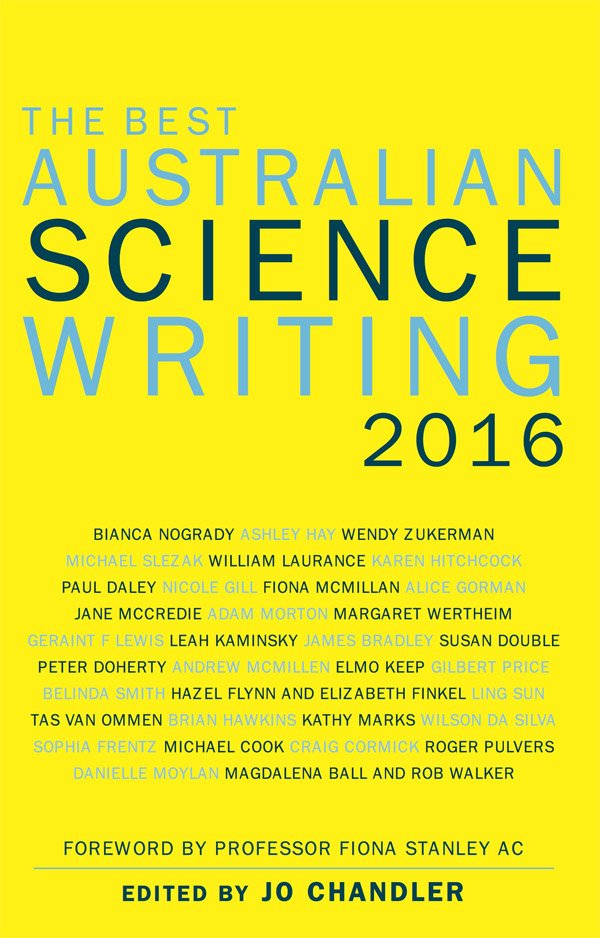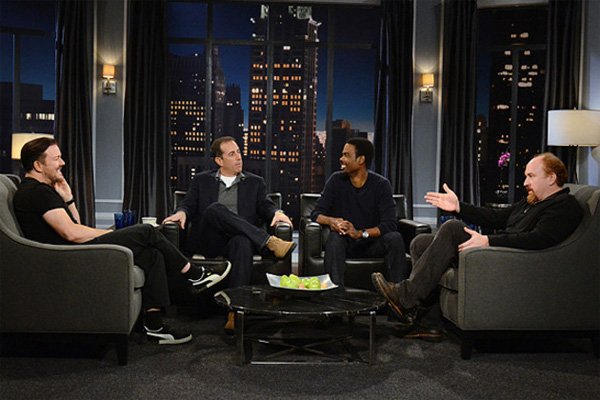Dispatches #131: Fruit ninjas, borderline personality disorders and violin thieves
Thursday, 10 November 2016
Welcome to Dispatches, a weekly summary of my writing, listening and reading habits. I'm Andrew McMillen, a freelance journalist and author based in Brisbane, Australia.I have no new published words to share this week, but some exciting news: I'm a proud contributor to this new book.

I'm thrilled to be published in The Best Australian Science Writing 2016 by NewSouth Books, alongside great writers such as Karen Hitchcock, Leah Kaminsky and Elmo Keep! My article in this anthology is The Bone Collector, which was originally published in The Weekend Australian Magazine last October. It's about a researcher at the University of Queensland who is building an Australian-first skeleton library with the help of flesh-eating beetles. You can buy the book at stores nationwide. Stoked!
From the furthest reaches of the universe to the microscopic world of our genes, science offers writers the kind of scope other subjects simply can't match. Good writing about science can be moving, funny, exhilarating or poetic, but it will always be honest and rigorous about the research that underlies it.
Now in its sixth year, The Best Australian Science Writing 2016 brings together knowledge and insights from Australia's brightest thinkers as they explore the intricacies of the world around us. This lively collection of essays covers a wide range of subjects and challenges our perceptions of the world and how we exist within it.
Sounds:

Talking Funny (49 minutes). I have watched this several times since it first aired on HBO in 2011, and it's something I find myself coming back to around once a year, as the chemistry and comedy on display is irresistible. From what I gather, it was Gervais who brought Seinfeld, Rock and C.K. together for this unscripted conversation about making a life out of making jokes, and while it's fairly easy to pinpoint aspects of his insecurity in their company, I respect Gervais greatly for bringing them together, for our benefit. Apparently the full, unedited version of this chat runs for about four and a half hours, and I sure hope this turns up somewhere in the future, as it's truly a comedy artefact for the ages.
How does a simple idea end up becoming a signature joke? Why do some comics embrace profanity while others avoid it? Do audiences really matter? In this one-hour HBO special, four stand-up legends--Jerry Seinfeld, Chris Rock, Ricky Gervais and Louis C.K.--answer these questions and more as they let their guards down in an intimate, unscripted conversation about what it means to be a comedian, and how far each has been willing to go to push the limits of taste and originality for a laugh.
Roger Waters on WTF with Marc Maron (95 minutes). With this great conversation, Maron can cross another rock and roll great off his list. I'm a big fan of Roger Waters; I saw his performance of The Wall Live in 2012, which I reviewed for The Vine. It remains one of the greatest concerts I've seen.
Roger Waters wrote songs that changed rock and roll, organized them in ways that changed how albums were made, and performed them in ways that changed how concerts were staged. The Pink Floyd frontman tells Marc why he only now feels like he's getting it right. They also talk about his Pink Floyd bandmates, John Lennon, Neil Young, Eric Clapton, and the state of the world.
Tim Ferguson on Conversations with Richard Fidler (50 minutes). Two old friends natter on about all manner of things, including comedy, multiple sclerosis and B&S balls.
Tim rose to fame as a member of the comedy troupe the Doug Anthony All Stars. He has written and performed comedy for the stage and screen, and is also a teacher of comedy screenwriting. Tim was diagnosed with multiple sclerosis in 1994 and now uses a wheelchair. He hasn't let the disease dampen his warped sense of humour or slow the pace of his work. Tim recently toured Australia and internationally with the reformed DAAS performing the show Near Death Experience. He has co-written and co-directed the film Spin Out, based on the culture of the Bachelor and Spinster Balls in rural Australia.
Paul Bennett on Conversations with Richard Fidler (25 minutes). Another great Fidler interview, this one about the unique details that each of us leave behind as we walk, and how these foot-centric idiosyncrasies can be used in crime scene analysis.
Dr Paul Bennett has an eye for detail. He is a forensic podiatrist with a particular talent for identifying patterns left behind in footprints. His knowledge and expertise have assisted police in decoding evidence from crime scenes, including in the case of the murder of Daniel Morcombe. Paul is a senior lecturer at the Queensland University of Technology's School of Clinical Sciences.
Reads:

Australia's Most Successful Game Studio Is Having An Identity Crisis by Mark Serrels on Kotaku (3,400 words / 17 minutes). A great article by one of Australia's best videogame journalists about how the nation's top studio, Halfbrick, has changed following the success of its breakout title, Fruit Ninja. Well-written and credibly sourced, I expect this will be an interesting study even for those who don't follow or play games.
Date Night by Trent Dalton in The Weekend Australian Magazine (4,300 words / 22 minutes). A perceptive read about how apps like Tinder have changed dating and sex for young people. It's packed with insightful quotes – like this one from a 28 year-old woman: "That's why I think Tinder works for so many ­people. It removes the expectation of actual social interaction. You just get laid and then you go back into your own little bubble – and features a brilliant image in the kicker.In years gone by Halfbrick had a tradition. When an employee decided to leave there was a farewell. A slideshow, a card signed by everyone. A speech — a celebration — topped off by a ceremonial bag stuffed full of marshmallows. Weird, flippant. By design. A sense of closure to dedicated service in pursuit of one unified goal: the creation of unique, innovative video game experiences. A gesture reflective of the experience that — from the outside in — you might expect from a company like Halfbrick. Halfbrick. Australia's biggest, arguably most successful, video game studio. Halfbrick: the golden child. Halfbrick: the success story. Halfbrick: the enduring symbol of an Australian games industry in full recovery. Halfbrick: the phoenix from the flames. After years of redundancy, studio closures and flat out misery, Halfbrick: everything we wanted Australian game development to represent. Verve, creativity, agility, polish, quality. Independence. Halfbrick: the dream in action. But Halfbrick as we once knew it has changed, and has been changing — according to sources — for years now. From the outside in Halfbrick has always existed as a static enduring example of success; living, breathing proof that Australia has a games industry worth believing in. From the inside out; a different story. Halfbrick: a studio with a powerful, damaging identity crisis. Halfbrick: a company teetering on the edge of a chasm it doesn't quite understand, can't quite traverse. Over the past six months we've spoken to numerous sources within Halfbrick. Ex-developers, ex-designers. Some left years ago, some left as recently as last month. But they all tell the same story. And that story begins with a little game called Fruit Ninja.
'She Was Begging For Help' by Kate Legge in The Weekend Australian Magazine (3,300 words / 17 minutes). This is the first time I've seen borderline personality disorder (BPD) explored at length in a mainstream Australian publication, and I found it to be a comprehensive and thoughtful read about a disorder that's among the hardest to diagnose and treat. In the recent past, mental health professionals were simply untrained in treatment: as a psychiatrist tells writer Kate Legge, "We were told there is nothing you can do, that it is a hopeless condition and we should just leave patients alone."Game on, boys and girls, and tonight's jackpot prize is the same as it was last Friday night, a confidence-boosting bonk and a heart that can't be ­broken. Cavill Avenue Mall, Surfers Paradise: a frenetic mix of neon bars, restaurants and thousands of mobile phones ­zipping invisible text messages between dating apps across the Gold Coast. Short questions and shorter answers escalating through cyber space. “Sup Tinderella?” “Do u live close by?” “What's your favourite movie?” “Can you be a freak in the sheets?” Manners, like communicating with your voice box, are so 2010. Daniel Byrn jags a right-swipe match. He's the 26-year-old carpenter squeezed along a bench seat with three mates from Melbourne. A boys' weekend. A girl around his age has sent a message to his Tinder page. She's pretty and, more importantly, she's nearby. “Hello, what's up?” she asks. Daniel's Friday night sexual fortunes rest on the tone of his response. He takes wise counsel from his mates. “You gotta be blunt,” says Nicholas Avery, a 24-year-old plumber. “Just say, ‘DTF?'” says another friend, the oldest of the group. DTF? “Down to f..k?” The boys howl with laughter. And this is the bit where you realise the world doesn't belong to you anymore and maybe never did.
Latina Hotel Workers Harness Force of Labor and of Politics in Las Vegas by Dan Barry in The New York Times (1,900 words / 9 minutes). A beautifully written portrait of an American hotel cleaner, which ends with one of the most artful kickers I've seen this year. It might read a little different today, in the wake of a certain election result, but I urge you to read this one through right to the end.Sophie Nicholas gazes from a ­photograph stuck to the fridge door in the kitchen of her family's Melbourne home, her intense eyes crinkled with laughter in a moment of exhilaration, her long brown hair swept back from her face on a windy day when the troubles that cursed this 26-year-old hid from sight. Pale pink and cream rose petals dry on wire trays atop the wooden table near a towering pile of condolence cards as her mother Kerry leafs through a large file tracing Sophie's chaotic shuffle between rehabilitation and emergency departments as she wrestled alcoholism and borderline personality disorder (BPD). The paper trail chronicling multiple admissions, discharges, psychology reports, police statements and health insurance claims during the past two years obscures a darker tale of heartbreaking ­failure to treat a mental illness that is complex, challenging and misunderstood. Kerry tries to make sense of the tipping points: Sophie's desperate voice in a 3am phone call when she'd been ­discharged yet again from emergency with nowhere to go; the sight of her dishevelment after losing ­wallet, phone and possessions while intoxicated and homeless; the three days she went ­missing with enough medication to overdose before she was found camped in the back yard of an unoccupied house next door.
Masters Of Their Fields by Catherine McGregor in The Weekend Australian Review (2,000 words / 10 minutes). This is the most extraordinary book review I've read this year. The title in question is Stroke Of Genius by Australian author and journalist Gideon Haigh, who specialises in writing about cricket. Part examination of the work itself, part essay about how far ahead of his peers Haigh is, I can't help but concur with McGregor's assessment of his work in general, though I haven't yet read Stroke Of Genius.She begins her day in black, the natural black before dawn and the requisite black of her uniform: the T-shirt, the pants, the socks, the shoes with slip-resistant treads, all black. The outfit announces deference. She crams fresh vegetables into a blender and holds a plate over its mouth as the machine whips up her green liquid breakfast. Its whine sounds the alarm for her four school-age grandchildren who, one by one, emerge sleepwalking from corners of their crammed rented house. Time to go. Before shepherding the children into her silver Jeep Patriot, the woman straps on a fabric back brace and covers it with the last piece of her uniform, a gray and black tunic. Then, above her left breast, she pins two small union buttons beside her silver name tag. The combined effect says: This is Celia. Underestimate her at your risk. Celia Vargas, 57, with dark wavy hair restrained by a clasp, works at one of the hotels in perpetual gleam along and around the Strip. She is a “guest room attendant” and a member of the Culinary Union, one of more than 14,000 who clean hotel rooms while guests donate money to the casino of their choice.
The Stradivarius Affair by Buzz Bissinger in Vanity Fair (5,100 words / 26 minutes). A high-school dropout plans to steal a centuries-old violin worth several million dollars. It doesn't quite go to plan. This story, written by the author of Friday Night Lights, among other books and articles, sparkles with fine details and entertains all the way through.Stroke of Genius is the title of Gideon Haigh's latest work. It is an apt title, referring as it does to an image of batting perfection. The work is an extended rumination on probably the most famous photographic image of any cricketer in the rich iconography and mythology of the game. The stroke, commonly referred to as ‘‘jumping out'', shows Australian legend Victor Trumper at the Oval in 1905, poised at the height of his extravagant backswing, front foot airborne, just prior to executing his shot. There is no ball. There are no fielders, no stumps, nor umpires. There is simply a lithe, handsome man, frozen for eternity in a study of physical perfection, which Leonardo da Vinci would have been proud to contrive. The figure evokes a bygone era. Yet, there is also an element of permanence that only timeless genius confers on physical prowess. As Haigh points out, the photograph adorns the walls of pubs, clubs, homes and cricket grounds across the globe. Surely, neither Trumper nor George Beldam, the English photographer who immortalised him, could have imagined the resonance of this fleeting moment. Given how elusive accurate details of Trumper's life are, there is a paradoxical element of clarity and definition in this photograph that has eluded all the prose inspired by that abbreviated life.
How I Got Scooped by Michael J. Socolow on Inside Higher Ed (1,800 words / 9 minutes). A painful and slightly bitter read from an academic whose book idea became a bestseller a few years back. One problem, from his perspective, at least: he wasn't the author.Looking at it one way, there was a certain twisted creativity to it. It just isn't every day that a high-school dropout and twice-convicted felon, your basic street criminal, as he was described, is the alleged mastermind of a crime that no one in law enforcement the world over had ever quite seen. Maybe it wasn't the crime of the century, but it definitely was the crime of the century in Milwaukee. The city, known for beer, bratwurst, the Brewers, and frighteningly large portions at German restaurants, had never been a hotbed of headlines. But this made national and world news not seen since the days of the city's own serial killer Jeffrey Dahmer. The Milwaukee Police Department and the Federal Bureau of Investigation put out dozens of officers and detectives and supervisors to crack the case and find a suspect named Salah Salahadyn. Forty-two years old with a thin frame and the studied manner of someone trying very hard to be measured and professorial when he is neither, Salahadyn was a Milwaukee native and fancied himself a high-end art thief, according to police.
This is a story about a story. A story that might be worth millions of dollars. It's also a cautionary tale for academics who dream of writing best-selling books. One day in early 1999, I found myself awaiting the retrieval of books in the main reading room of the Jefferson Building at the Library of Congress. I was completing the research for my doctorate in history at Georgetown University. Passing the time by strolling through the alcoves circling the giant room, my eye caught the spines of a group of slim volumes resting on a shelf. They were a series of oral histories compiled by the LA84 Foundation, an organization assembled by the 1984 Los Angeles Olympic Committee that was tasked with, among other things, providing scholars and students with historical materials related to the Olympic Games. One volume contained an interview with Gordon Adam, a member of the University of Washington's gold medal-winning crew team in Berlin in 1936. Having been a collegiate oarsman, I started reading Adam's story. It was riveting.
Thanks for reading. If you have feedback on Dispatches, I'd love to hear from you: just reply to this email. Please feel free to share this far and wide with fellow journalism, music, podcast and book lovers.
Andrew
--
E: [email protected]
W: http://andrewmcmillen.com/
T: @Andrew_McMillen
If you're reading this as a non-subscriber and you'd like to receive Dispatches in your inbox each week, sign up here. To view the archive of past Dispatches dating back to March 2014, head here.